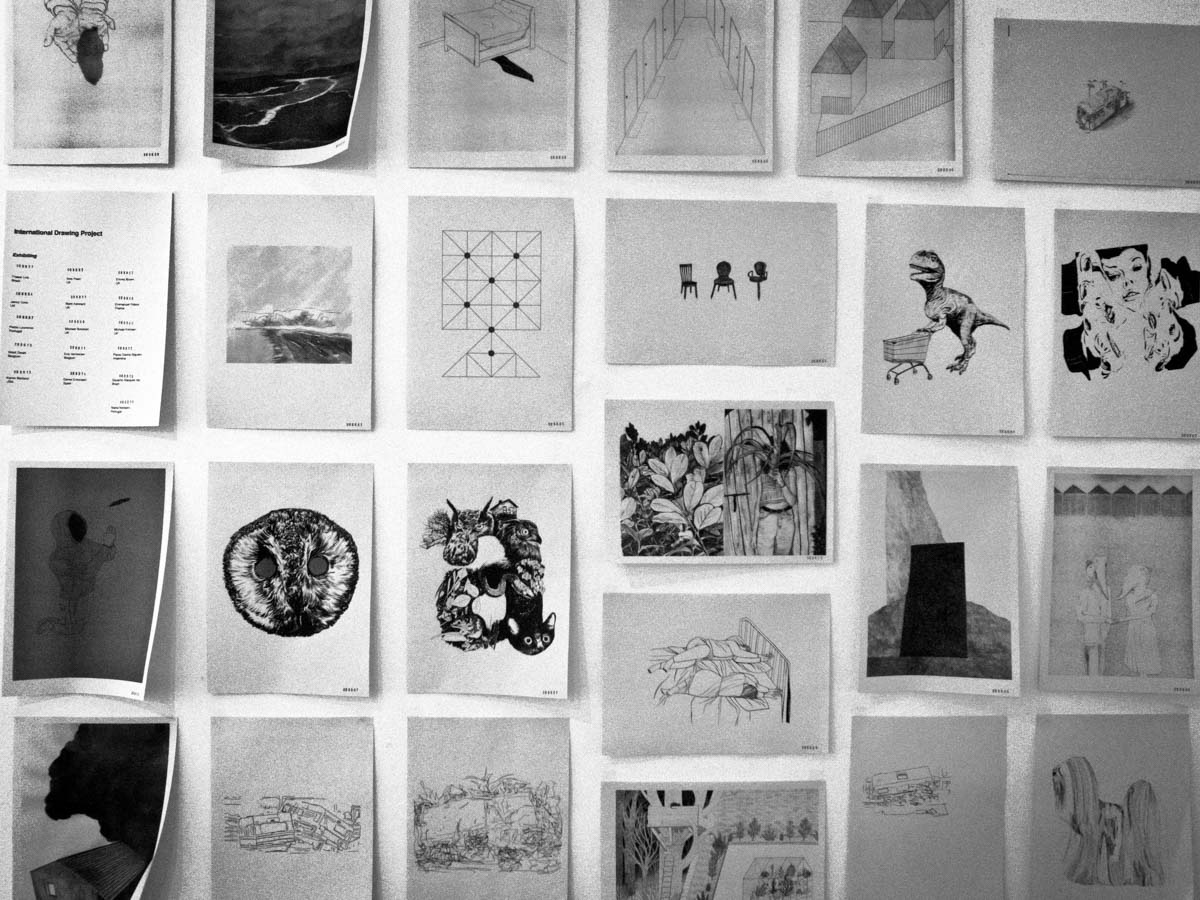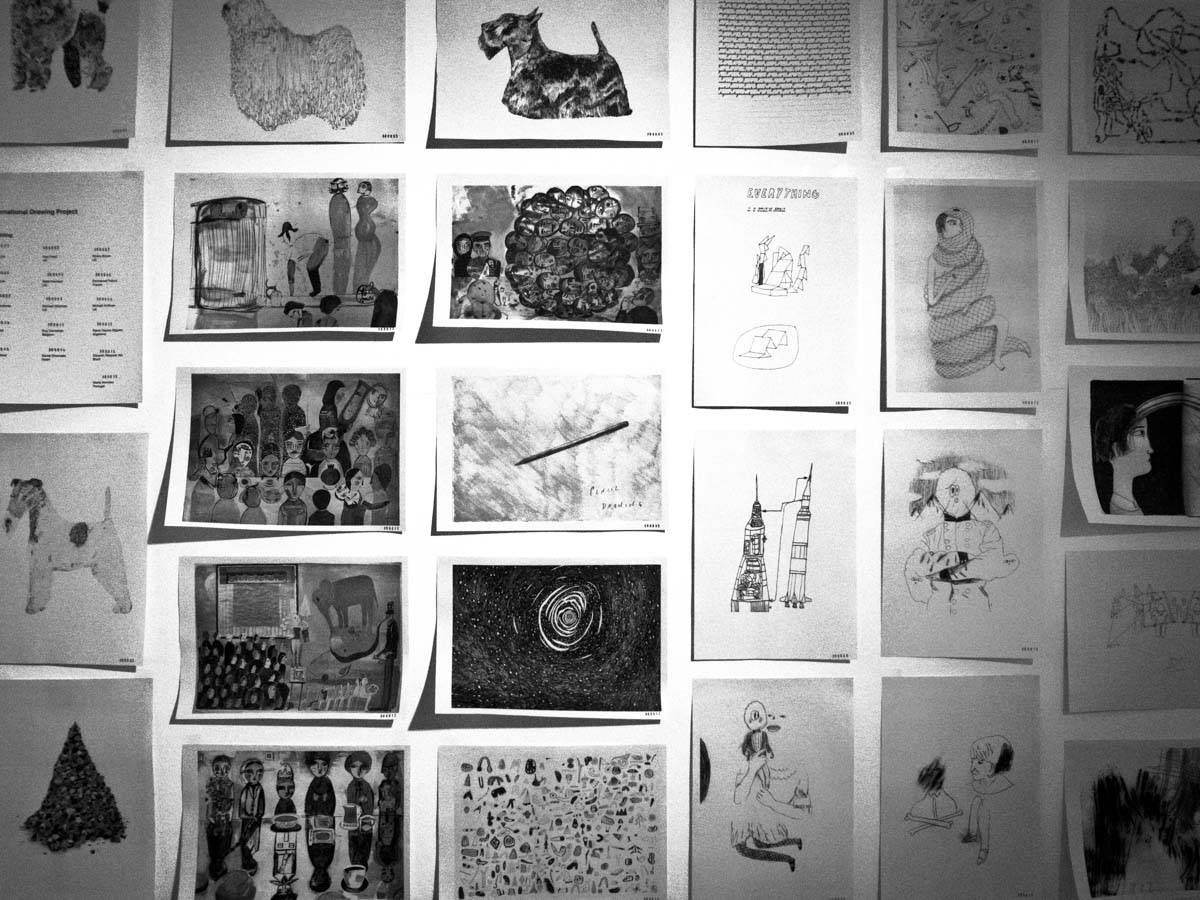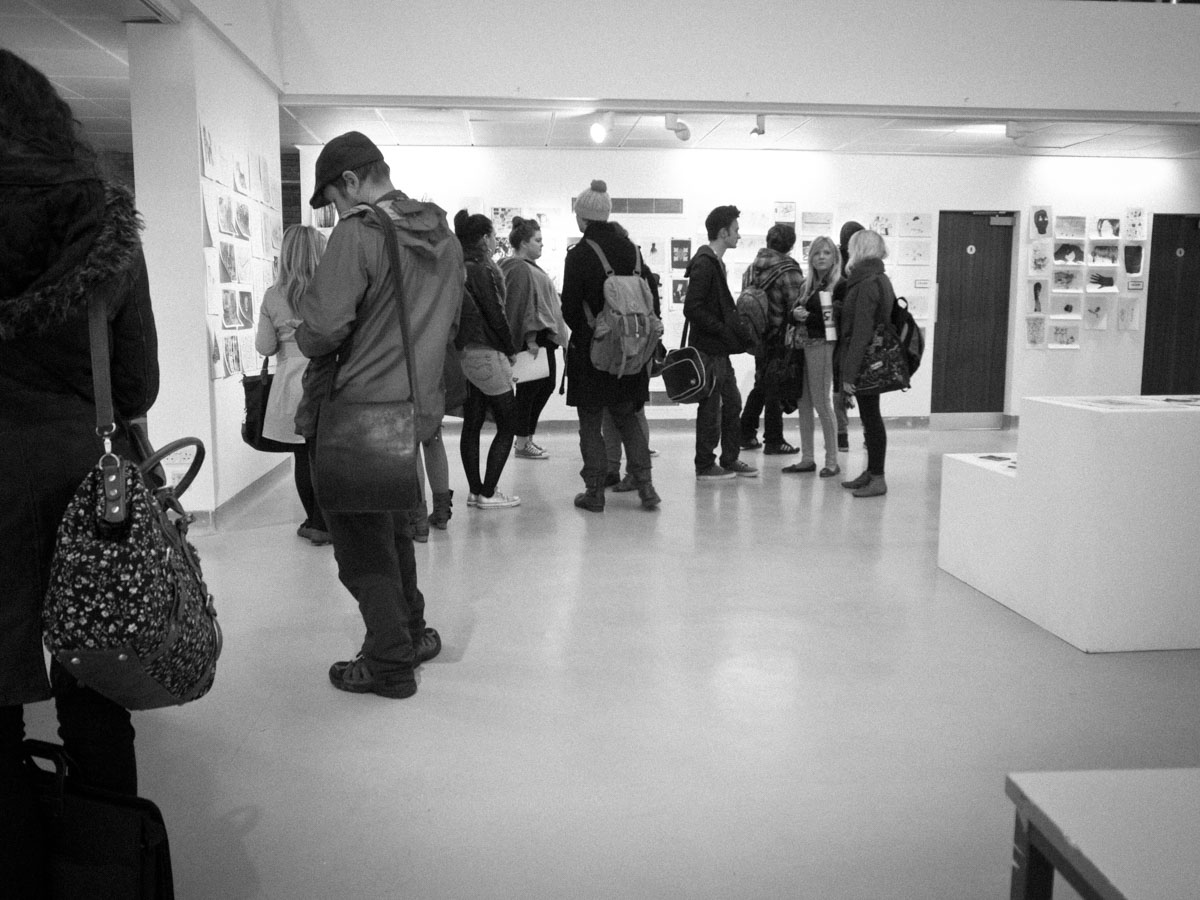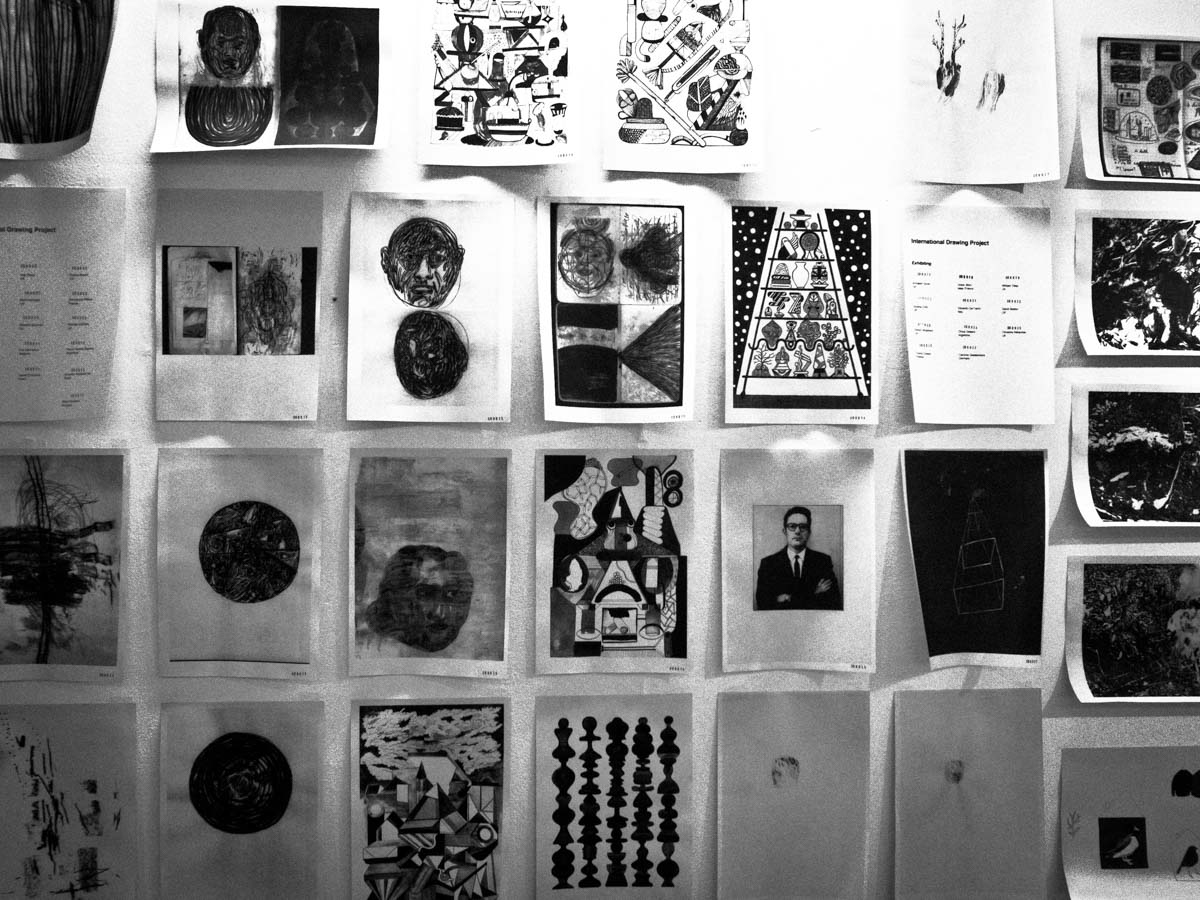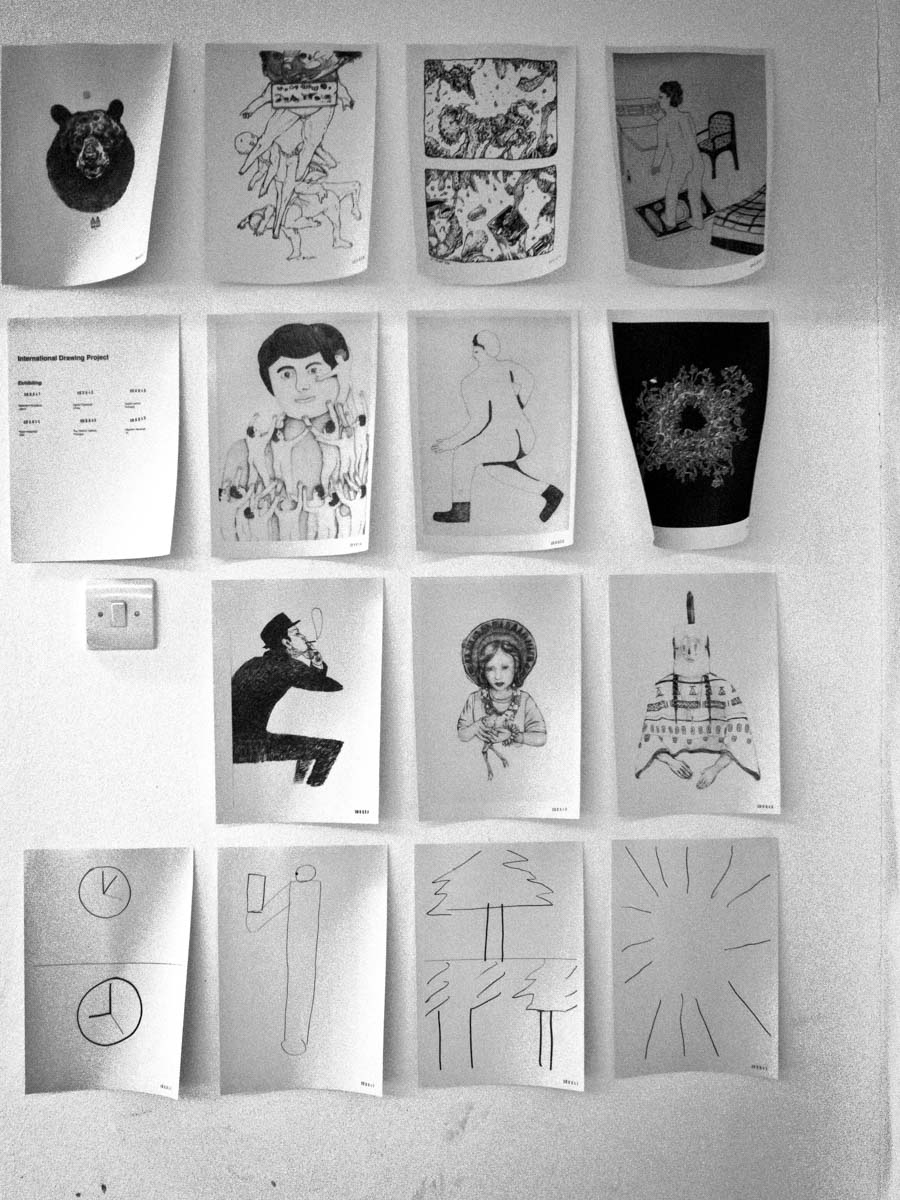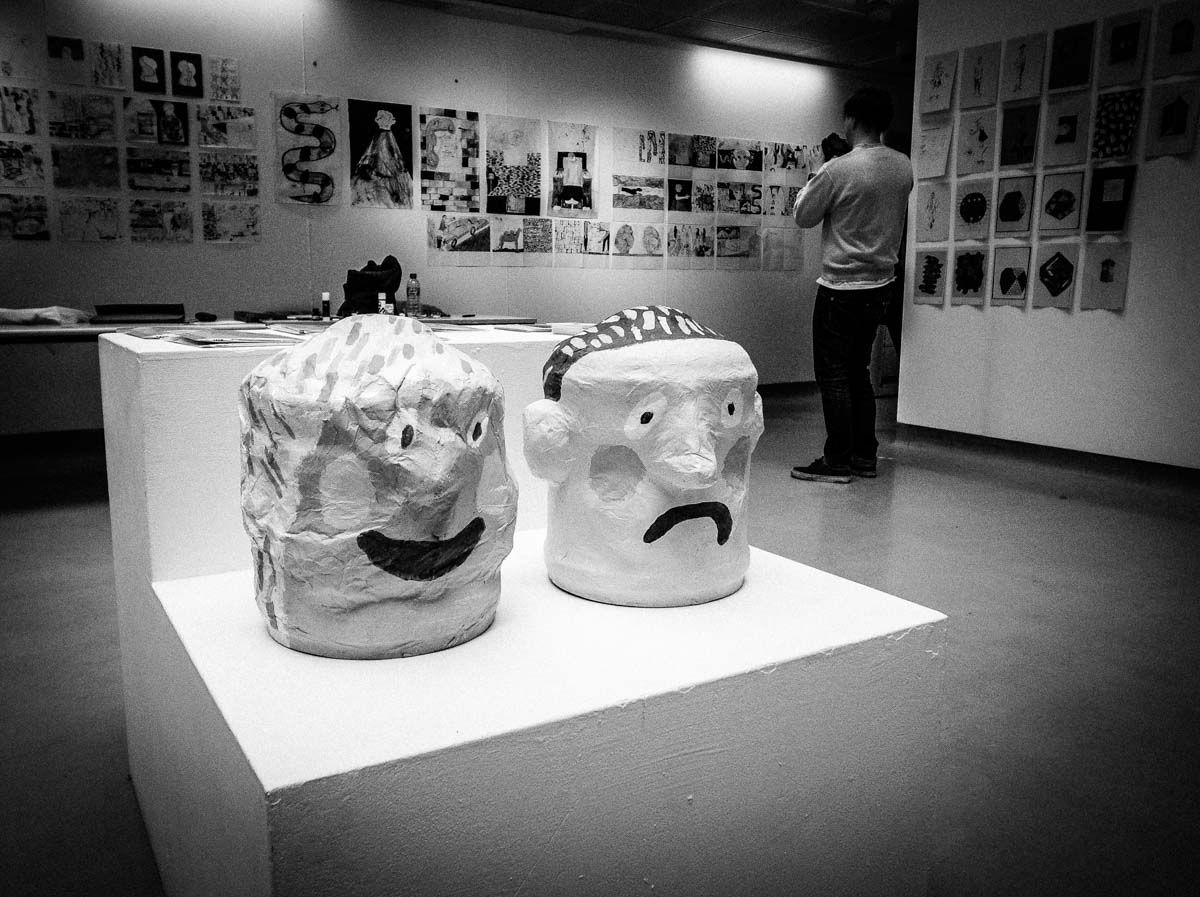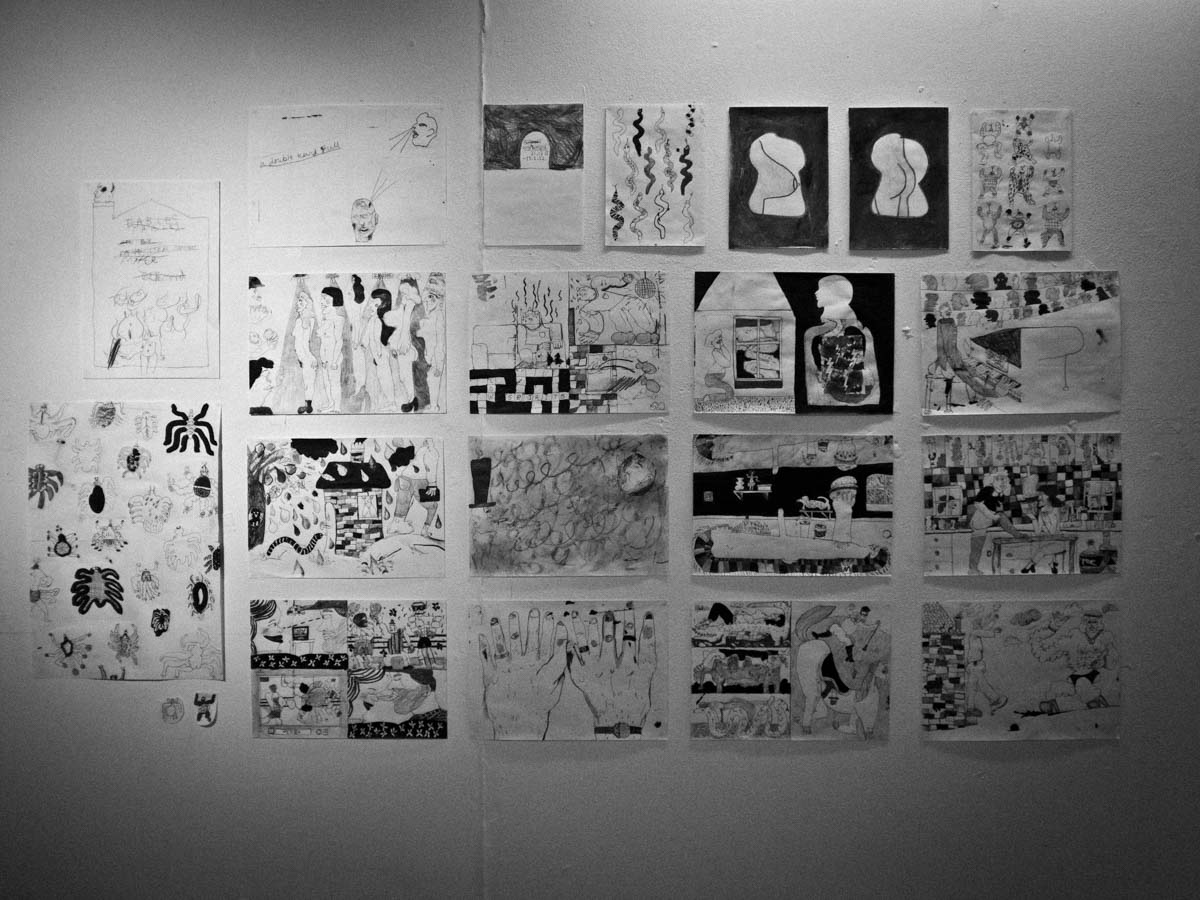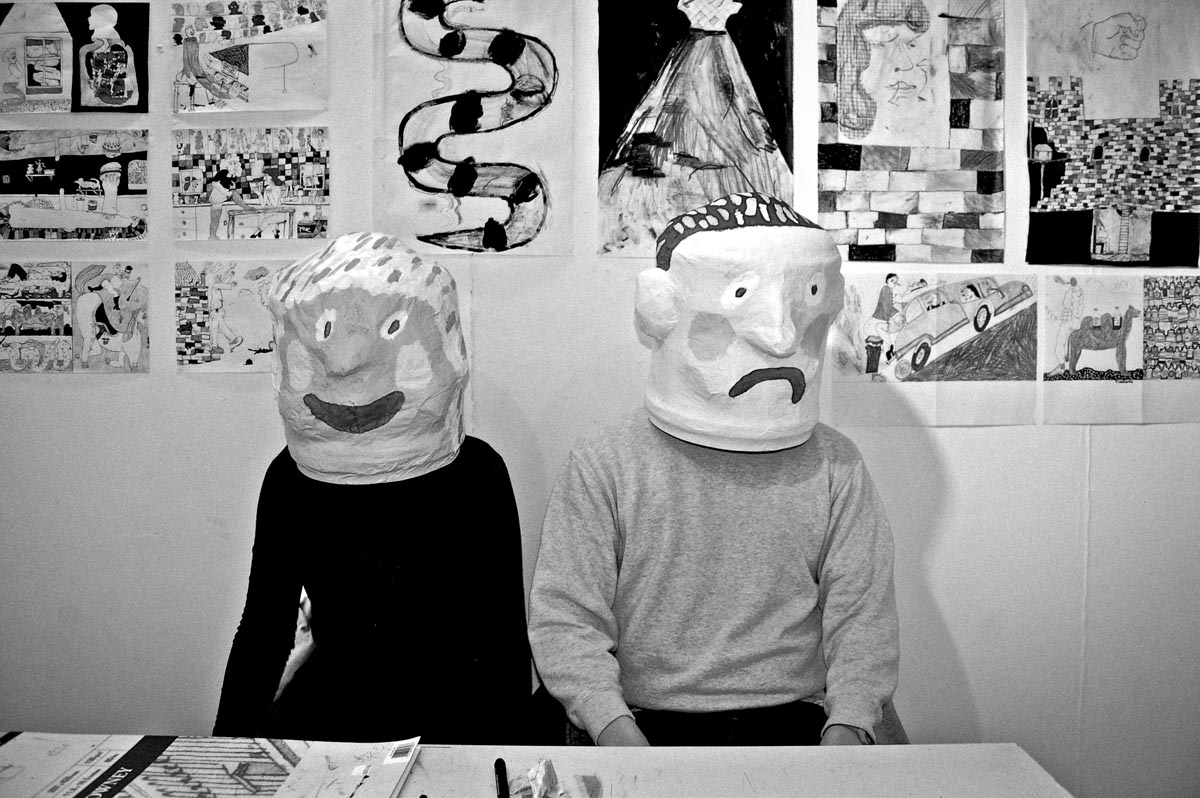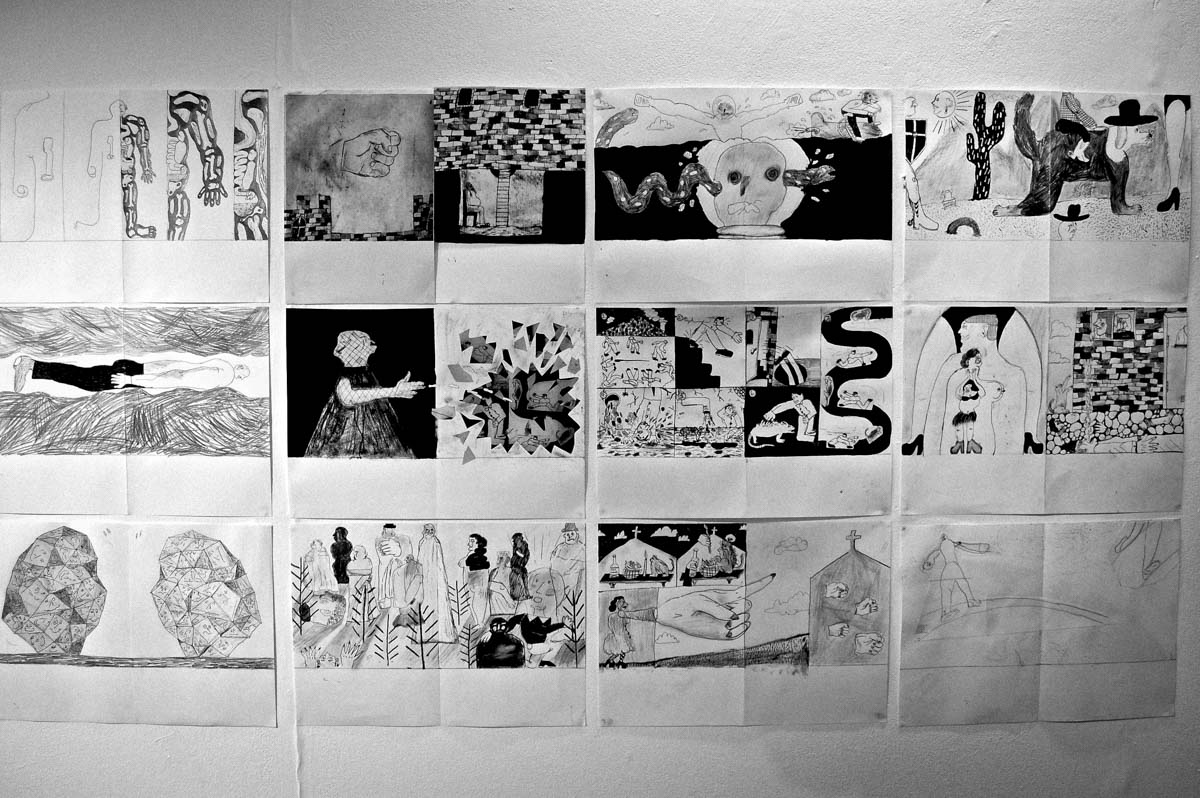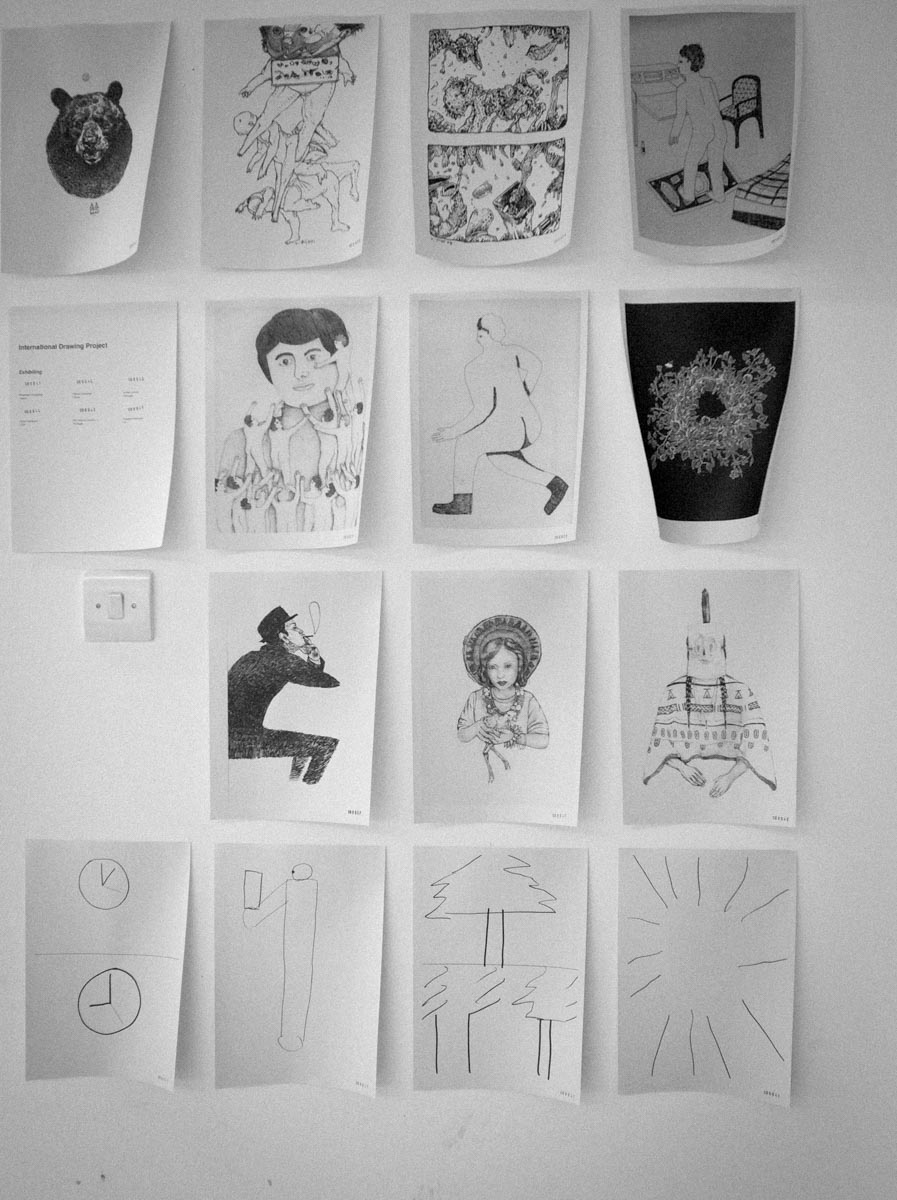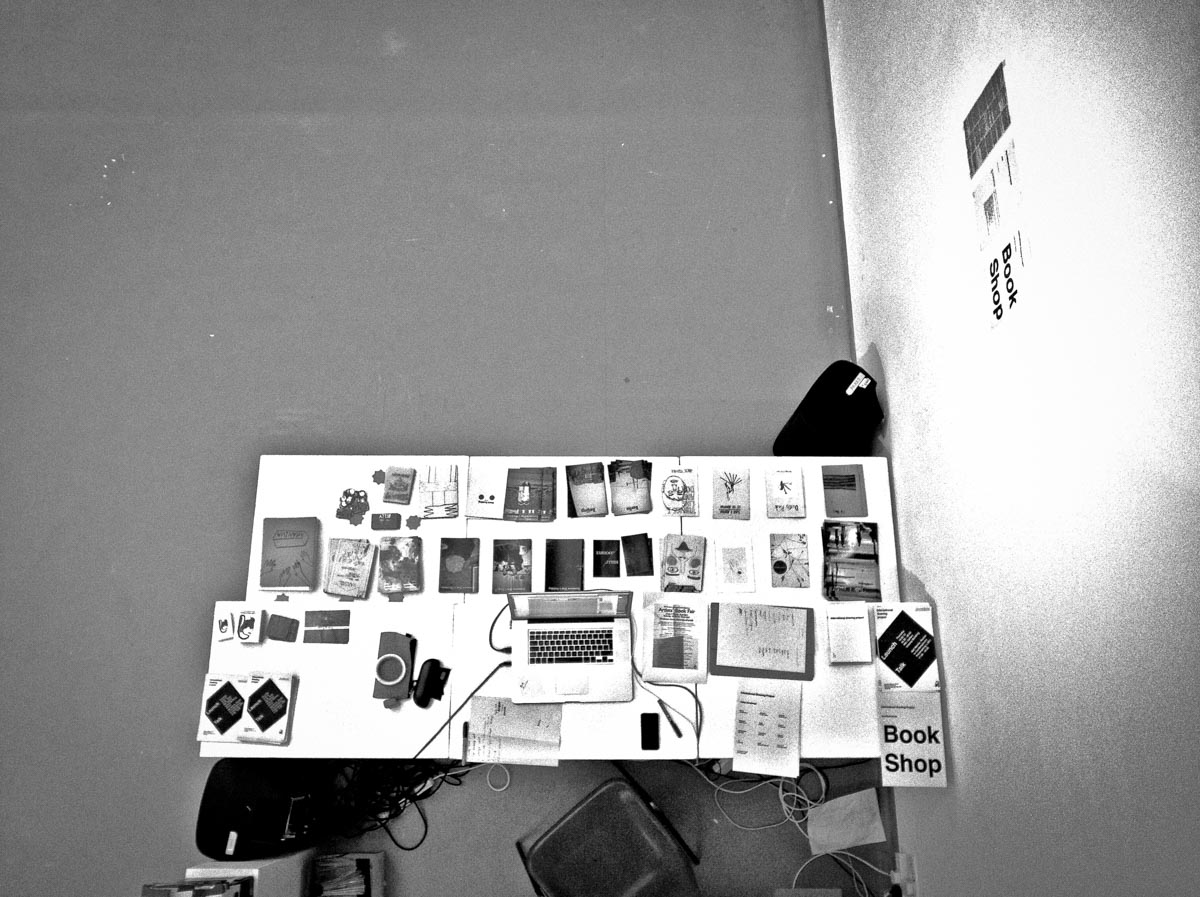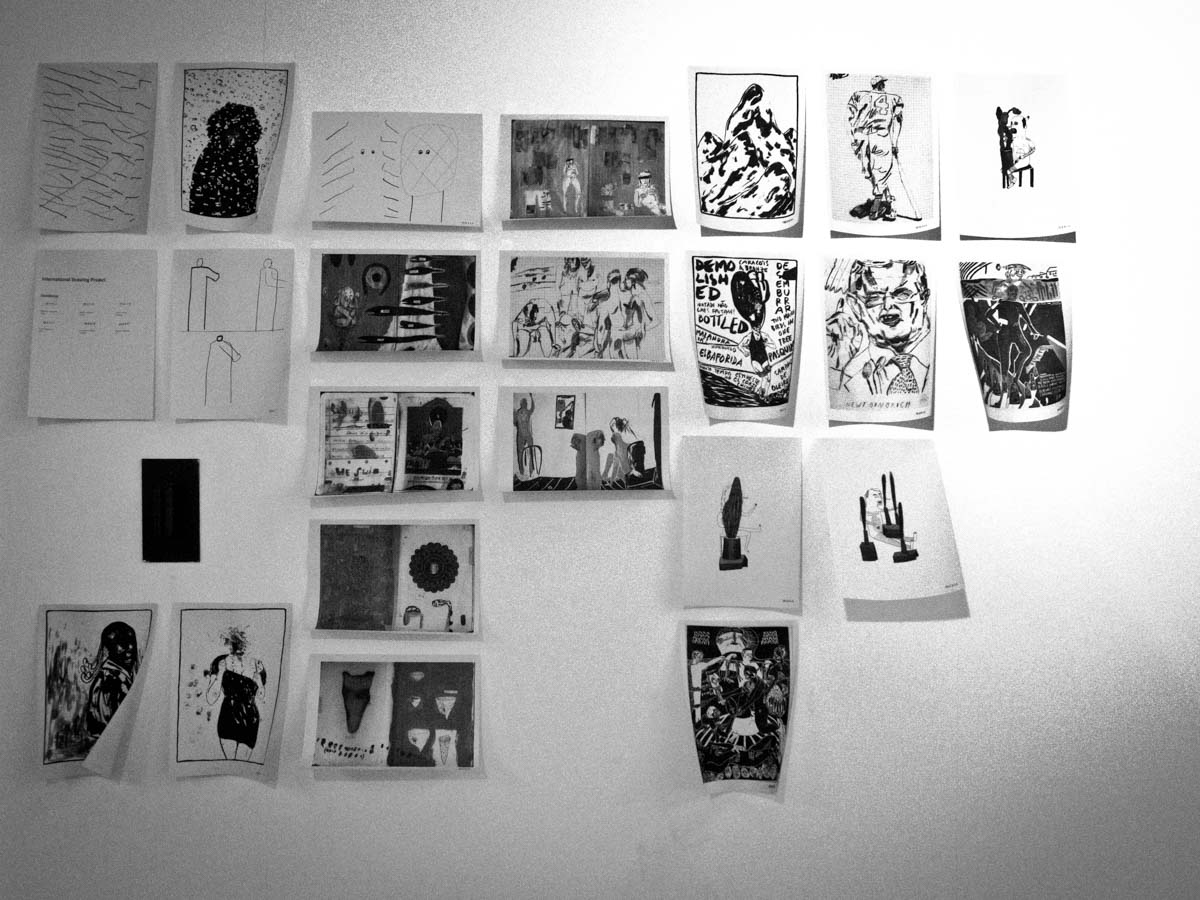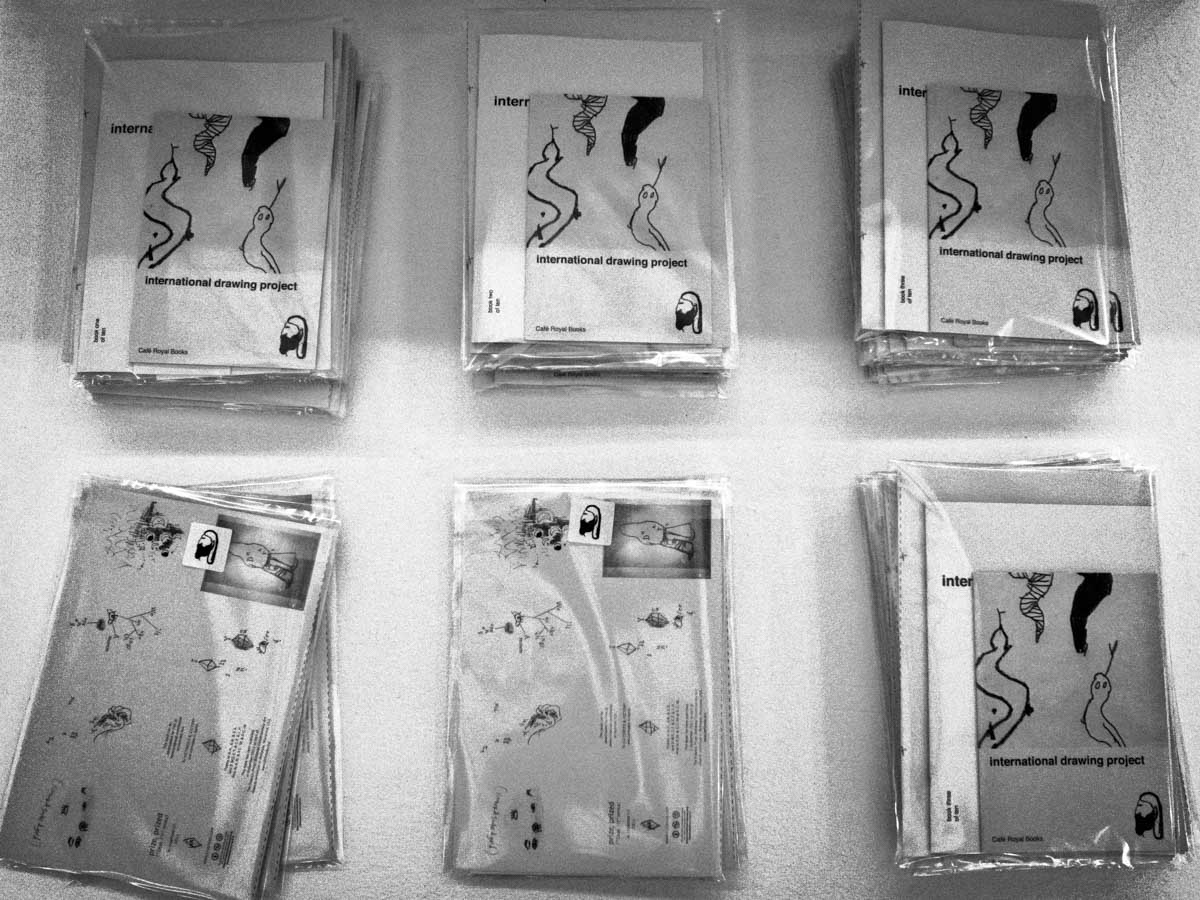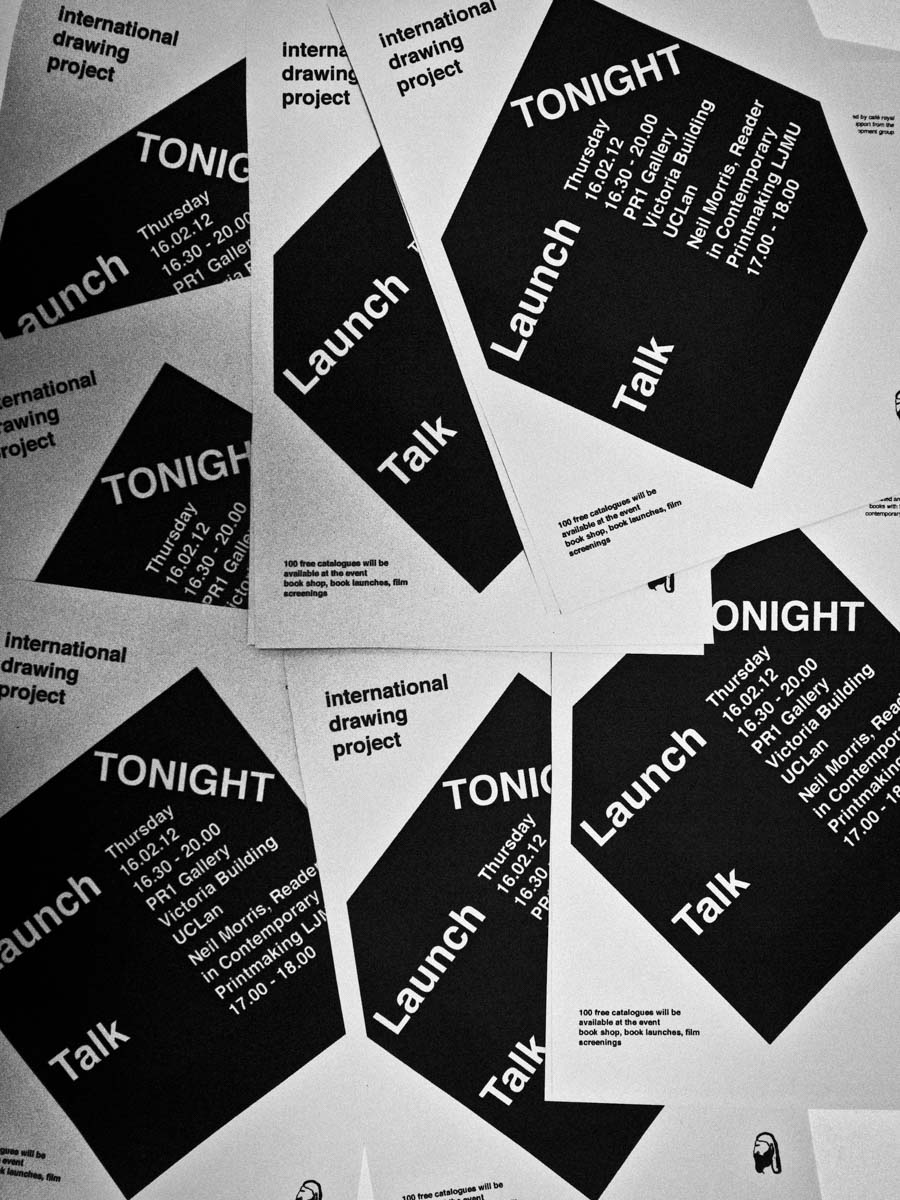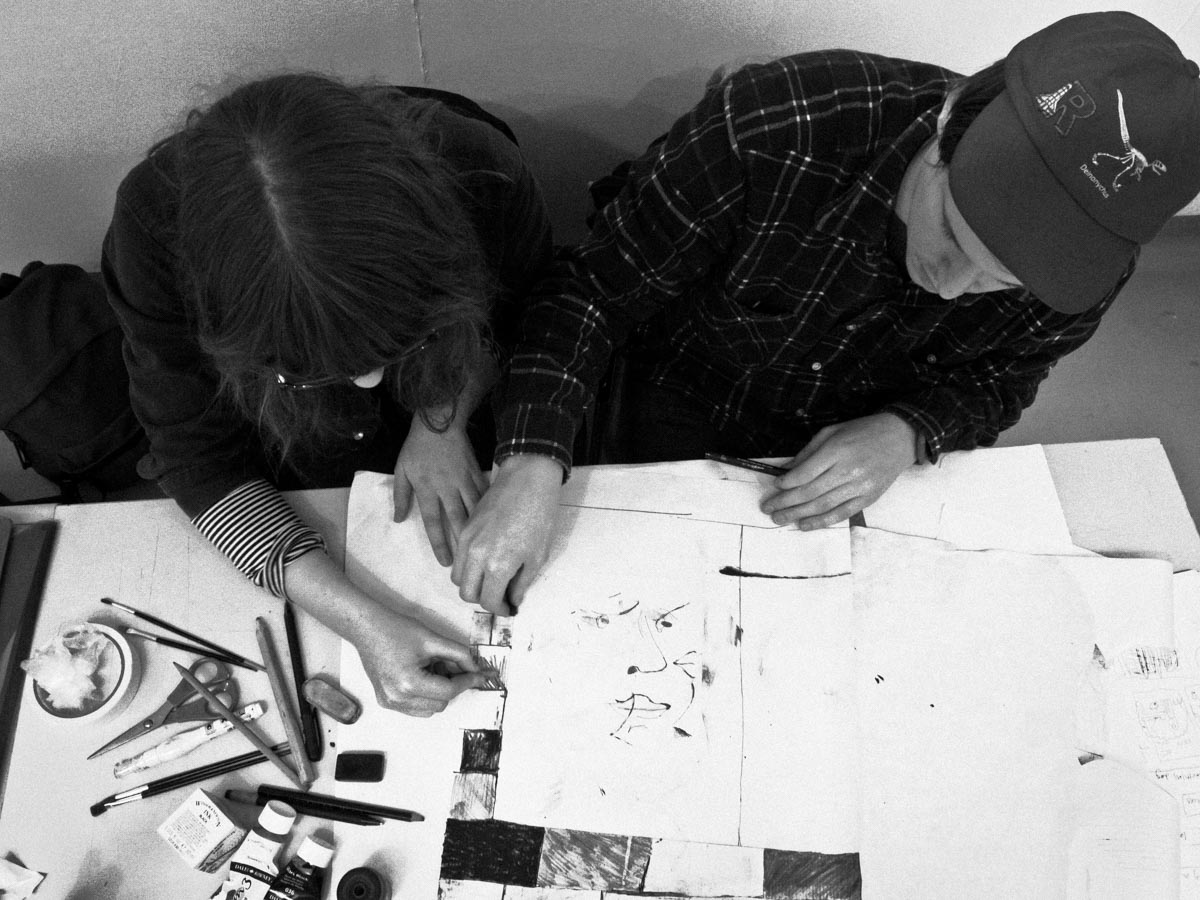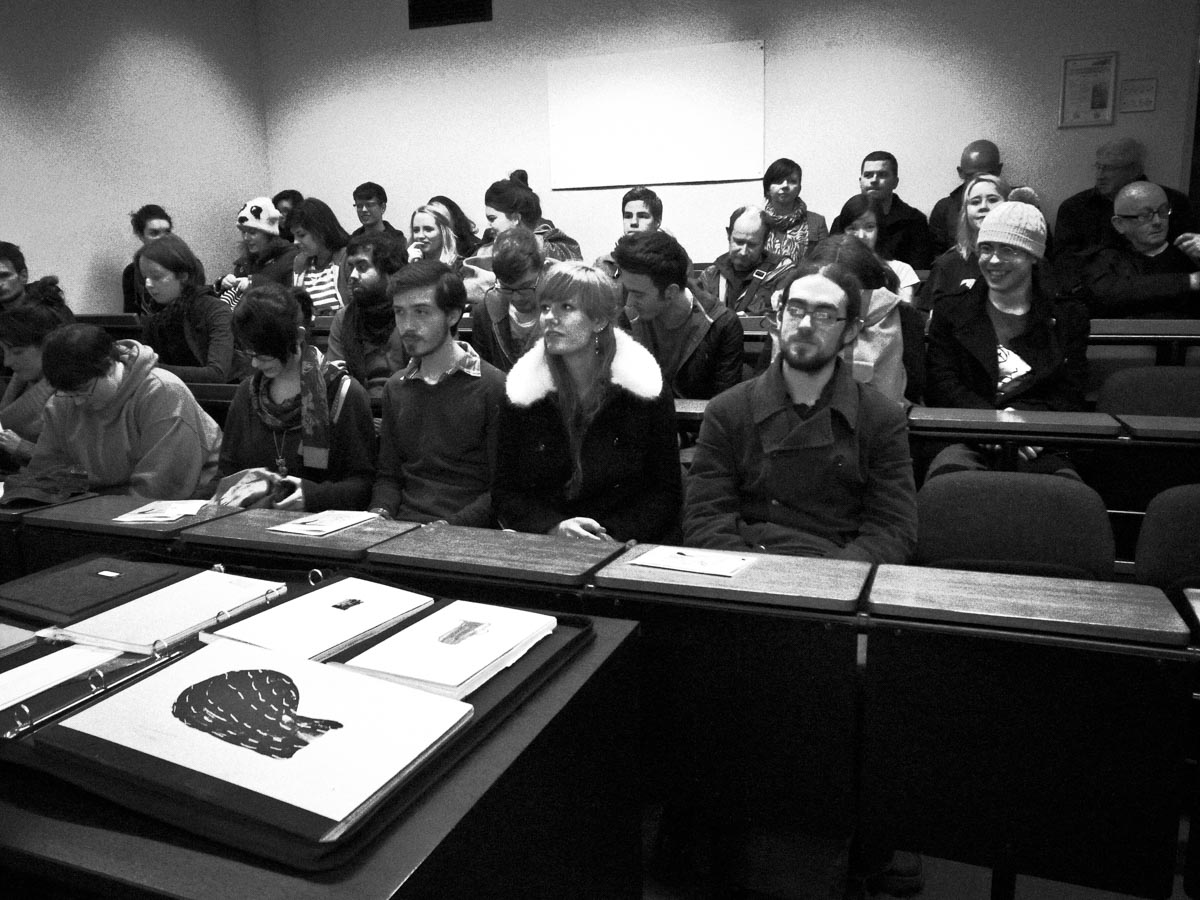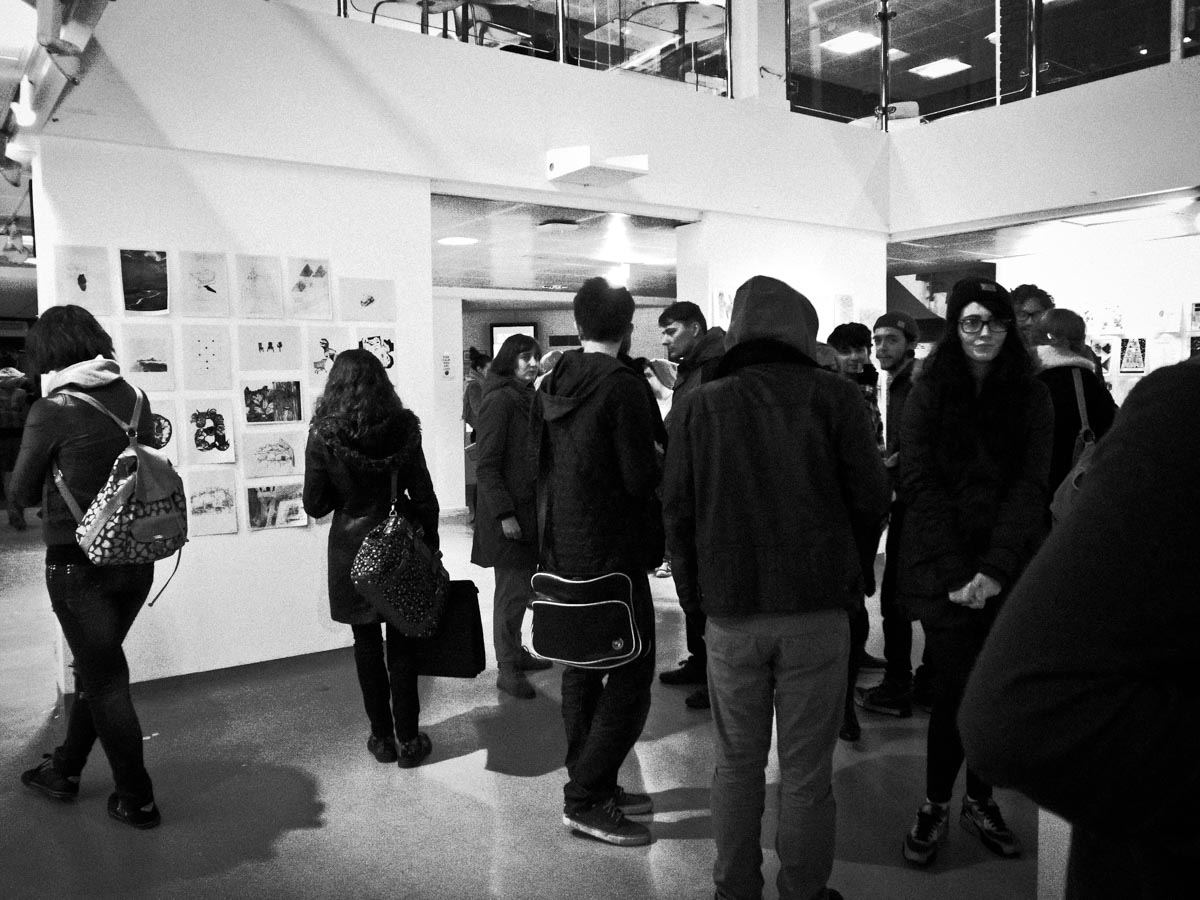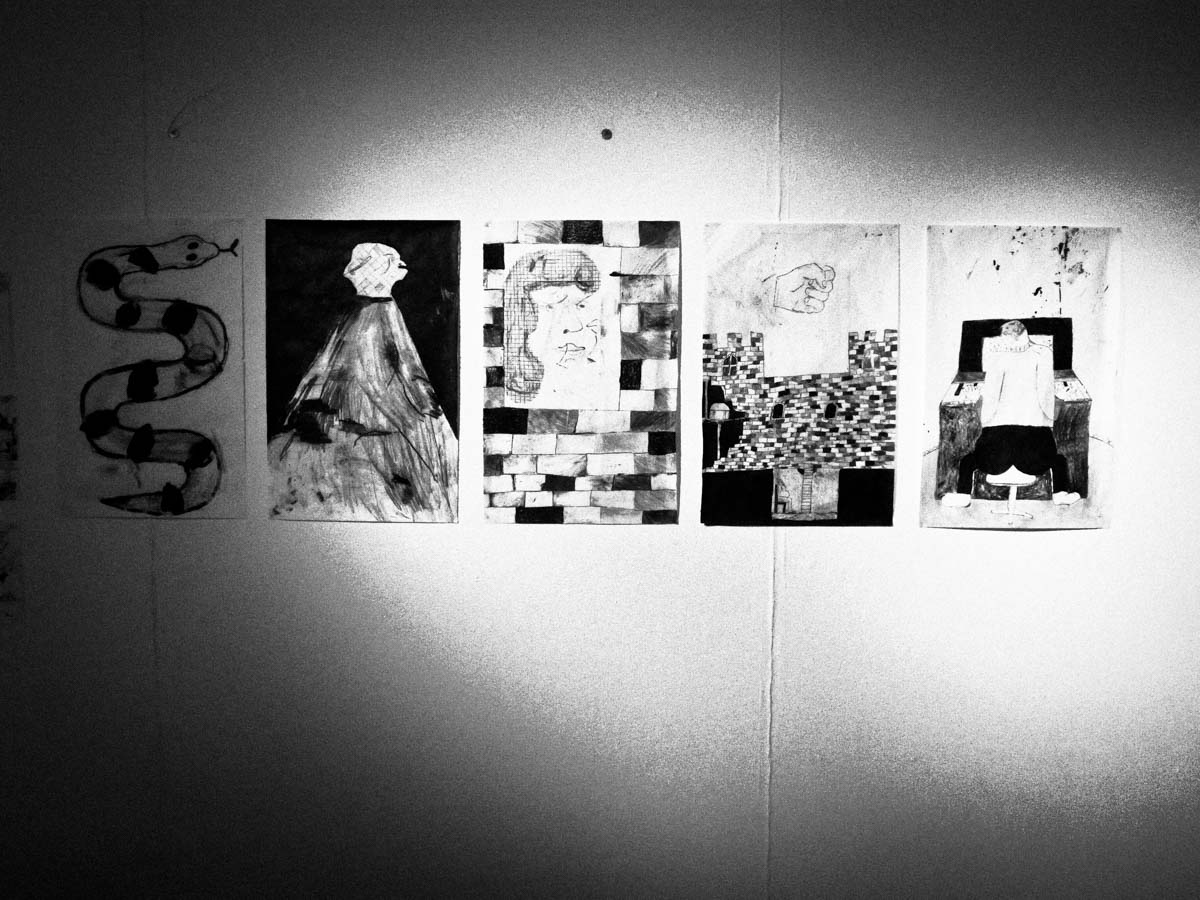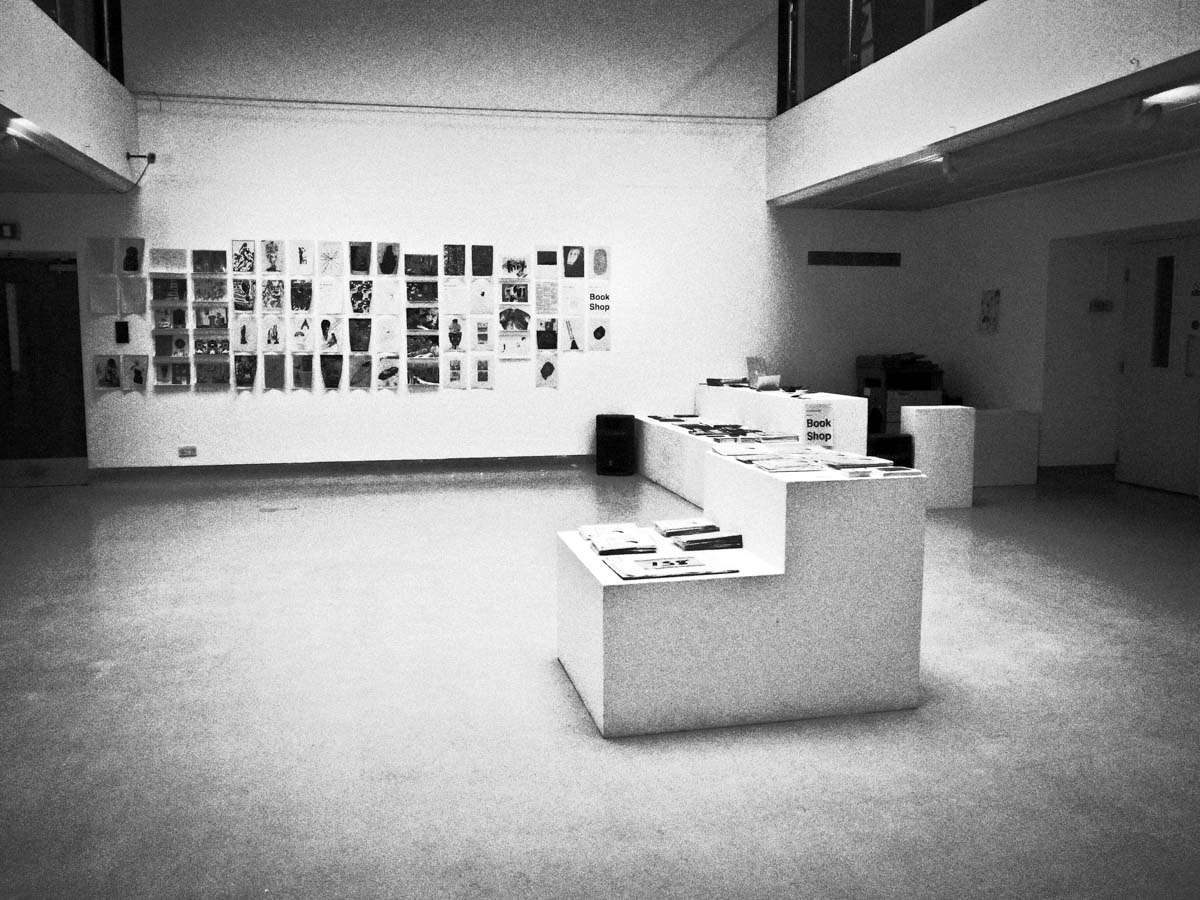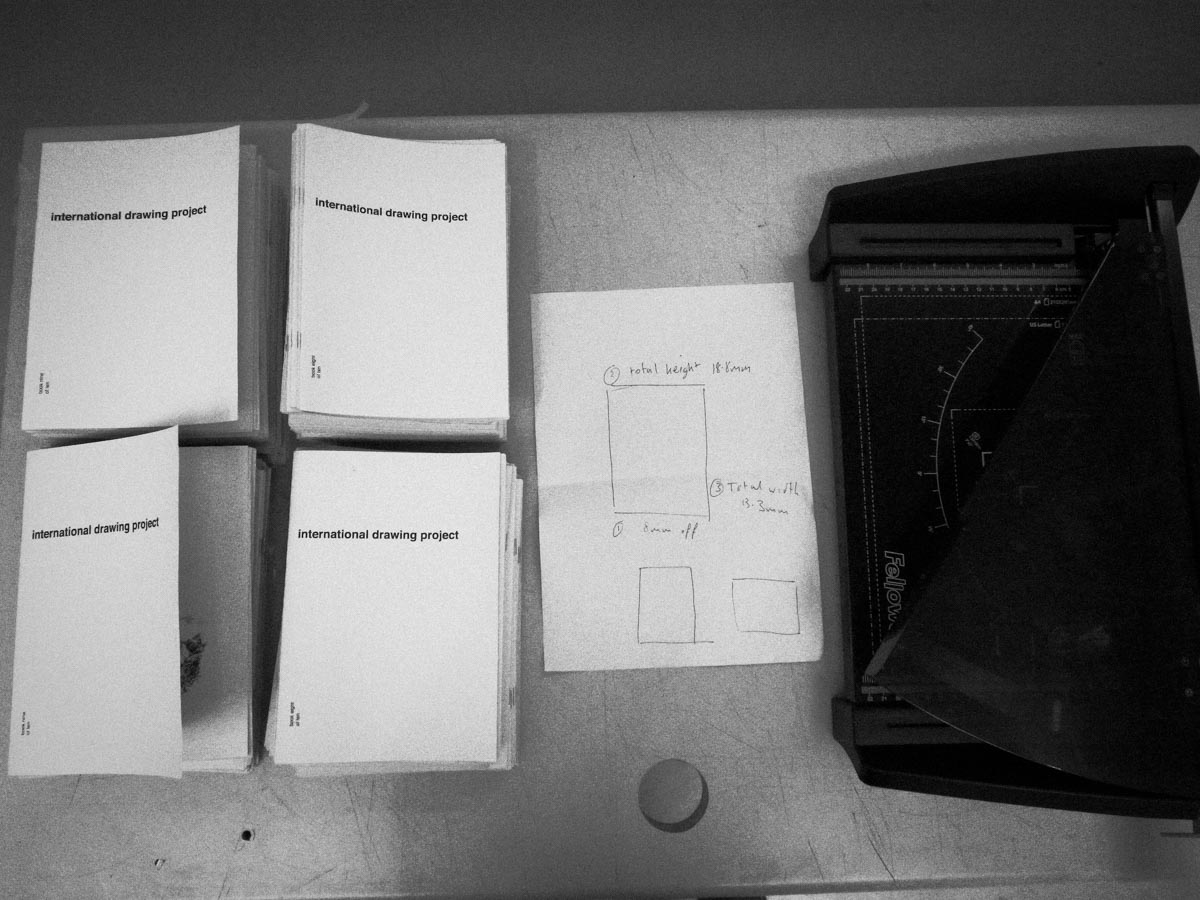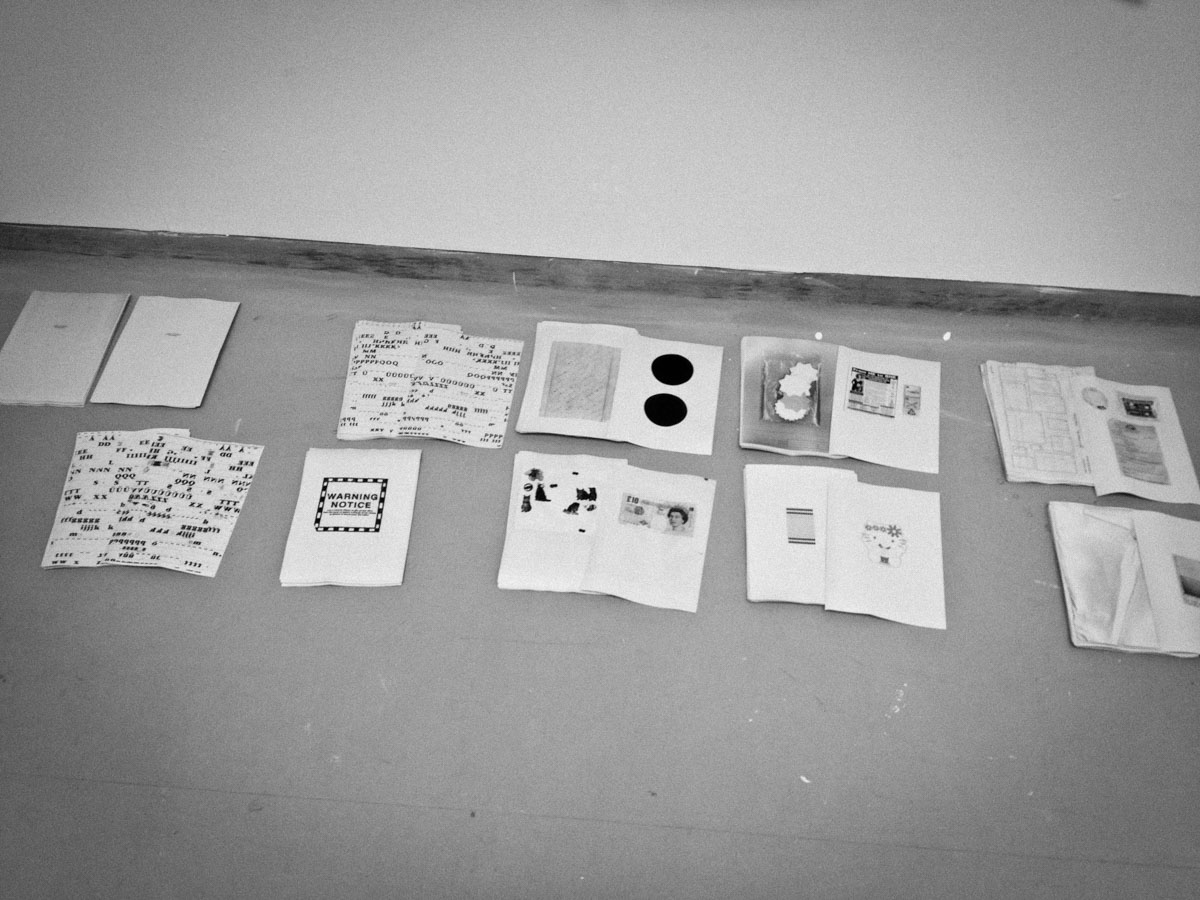February 2012 saw the first ‘International Drawing Project’. Over 6000 submissions were received. Work selected for the exhibition came from over 20 countries and included 80 artists working with film, drawing, and publications.
The project became a comprehensive survey of contemporary international drawing, a non country-specific coherent global ‘style’ was revealed.
The project was curated as if it were a book, rather than an exhibition. Curatorial strategies included standardising work by printing digitally, mono, on A4 paper and hanging work using a grid system. During the project I published ten different catalogues, each as an edition of 100. As each catalogue was published, the work of the artists included in the particular edition was both printed and hung in the gallery. Each artist was referenced with a catalogue number. The exhibition evolved over a three-week period. The catalogues are held in The British Library and are numbered with the ISBN 978-0955469381.
Artists in Residence were Mike Redmond and Faye Coral Johnson.
Essay was written by Sophia Crilly.
The events were held at PR1 Gallery, UCLan, UK[ the same venue as last years pop-up library] and supported by the Contemporary Arts Development Group. February 13th - March 2nd. Preview February 16th 2012.
Lecture was delivered by Neil Morris, Reader in Contemporary Printmaking at Liverpool John Moores University.
Included were screenings of work, and publications by David Macintosh[The Curtain], Steve Wilkin [738 newspaper], Himaa [Masanao Hirayama], Craig Atkinson, Sarah Haug aka VJ Steaknet, Warren Craghead, Mike Redmond and Faye Coral Johnson.
With each edition of the catalogue will be different 'make yourself' mini book by Warren Craghead.
IDP1
Published 13.02.12
Thales Lira / Brazil
Jenny Core / UK
Pedro Lourenco / Portugal
Ward Zwart / Belgium
Emmanuel Pidoux / France
Alex Pearl / UK
Michael Kirkham / UK
Karen Barbour / USA
Emma Brown / UK
Mark Kennard / UK
Paola Gaviria Silguero / Argentina
Michael Soloman / UK
Marta Monteiro / Portugal
Eva Vermeiren / Belgium
Eduardo Marques Vaz / Brazil
Daniel Entonado / Spain
IDP2
Published 14.02.12
Annabel Dover / UK
Didier Blondeau / France
William Titley / UK
Sophia Crilly / UK
Edoardo De Falchi / Italy
David Barton / UK
Simon Woolham / UK
Chica Desario / Argentina
Christina Mitrentse / UK
Fanny Dreyer / France
Caroline Gaedechens / Germany
IDP3
Published 15.02.12
Adam Shield / UK
Michelle Ramin / USA
Samuel Breton / Canada
Beth LaRoche / USA
Tommy Coleman / USA
Juan Chavarria Jr. / USA
Gabriela Piserchia / Argentina
Roland Icking / Austria
Yara Erazo / USA
Santiago Guevara Gómez / Colombia
Carlos “Zingaro” Alves / Portugal
Corey Cavagnolo / USA
Hrefna Sigurðardóttir / Iceland
IDP4
Published on the occasion of the International Drawing Project launch on 16.02.12
Masanao Hirayama [Himaa] / Japan
Henrik Drescher / China
André Lemos / Portugal
Ryan Haywood / USA
Rui Vitorino Santos / Portugal
Stephen Marshall / UK
IDP5
Published 20.02.12
Audrey Ohlmann / France
Marcus Gunnar Pettersson / Sweden
Mengyang Wang / China
José Manuel Hortelano-Pi / Spain
Dans Le Ciel Tout Va Bien / France
Maria Petersen / Portugal
Christopher Harnan / UK
Patrizio Anastasi / Italy
IDP6
Published 21.02.12
Aaron King / USA
Alana Richards / Germany
Anthony Cudahy / USA
Antoine Caecke / Belgium
Carla Wright / UK
Cheng Jingyan / China
Duarte Encarnação / Portugal
IDP7
Published 22.02.12
David Alker / UK
Egle Zvirblyte / UK
Ella Plevin / Germany
James R. Moore / UK
Jonathan Pilkington / UK
Linda Hemmersbach / Germany
Jin kui Zhou / China
IDP8
Published 27.02.12
O Hezin / RO Korea
Lou Benesch / Belgium
Mahsa Rahbari Aghdam / UK
Mark Bohle / Germany
Mark Farhall / UK
Matt Scobey / USA
Michael Howlett / UK
IDP9
Published 28.02.12
Phil Marsden / UK
Quentin Chambry / France
Rachel Larkins / UK
Roderick Mills / UK
Rosie Eisor / Bulgaria
Craig Atkinson / UK
Wai Wai Pang / UK
IDP10
Published 23.03.12
IDP10 is an overview and culmination of the International Drawing Project.
All catalogues are now out-of-print. There is a flip-through of each below.
Catalogue Essay
Some Notes on Drawing by Sophia Crilly.
1. Stratum / Schema *1
“As a primary response to the world, drawing is an outward gesture that links our inner impulses and thoughts to the other, through the touching of an inscriptive surface with repeated graphic marks.” *2
Standard definitions of drawing practice offer simplistic summarisations - to trace or produce a picture or diagram, likeness or representation (of someone or something) by making lines and marks (with pencil, pen, etc) on a surface (paper). Yet we know it to be so much more than this.
Prior to the existence of language (symbolic, written and spoken), drawing is historically the first art form and the primary means of expression and communication. Today, it exists anywhere and everywhere, a global visual mode of communication when verbal language barriers occur. A solitary or shared activity, it is a common act, non-discriminatory, accessible to all, whether the absent-minded doodler or professional artist who uses drawing as their sole medium.
Drawing is an intimate, cognitive process, and can be simple or complex, a single meandering line or extensive cross-hatching, re-working and layering process. Minimal materials are required to produce an instantaneous and immediate image through a few gestural marks. Often, conventionally, referred to as the most direct and spontaneous form of expression (with an extraordinary range of possibilities for personal expression), it can be seen as a way of thinking, of mediating on ideas, the representation of form and the graphic expression of a visual experience.
Two principal aspects or current tendencies in drawing can be identified. Firstly, the conceptual, theoretical and philosophical discourses that are grounded in abstraction, mark-making and surface; a trajectory that can be traced from Neolithic marks on cave walls to Conceptual practices of the 1960’s. Secondly, an emotive and associative, ‘felt’ response to what drawing is, it’s relationship to human experience; authenticity or ‘honesty’, immediacy, informality, intimacy, memory, narrative, and subjectivity. *3
The conceptual and process-orientated aspect of the medium, juxtaposes with the narrative, associative, reflective and subjective practice. Drawing is a medium in which diametric tensions can be, and are, constantly played out, though both its practice and the discourse surrounding it. It is a medium in continuous flux.
2. Material / Surface
Acrylic, Ash, Ballpoint, Biro, Brush, Carbon, Charcoal, Concrete, Crayon, Eraser, Felt-Tip, Gloss, Gouache, Graphite, Ink, Lead, Marker, Nib, Oil, Paint, Pastel, Pen, Pencil (B/HB/H), Pigment, Plaster, Photoshop, Putty, Quill, Smoke, Stick, Sticker, Wash, Watercolour.
A variety of weights and textured papers, found paper or material. Any other surface.
Unique. Edition. Multiple. Publication. Series. Sheet(s).
Physical and virtual distribution.
3. Method / Process
Drawing as process, is the gestural variety of the deposits and applications of these materials; economy or excess, layering, a synthesis of material and process, or a juxtaposition, uneasy alliance, surface tension. Half-erased images and ideas, repetitive linear strikings, set up new relationships. Composition and dimension are invented and inversed with a change of line or stroke, interactions of colour and material, a level of intensity, a start and break in momentum.
Reminiscent of the gestural excesses of Abstract Expressionism a vigorous scribbling can create cluttered, palimpsest working drawings.
Drawing is messy, imprecise (emotive, gestural, physical, textured, symbolic) and at the same time neat, precise (architectural, diagrammatic, logical, Minimalist).
4. Expand / Concept
Drawings can be referred to as (common within a gallery environment) ‘works on paper’. Such a category also expands the notion of what a drawing can be, potentially including lists, descriptive memos, plans, schematics. Works on paper are often a connection to moments in the art-making process, an idea in progress, a study or plan for something else; they might lead to another work, or can in fact be the finished piece.
This expanded field of drawing was highlighted through Mel Bochner’s 1966 exhibition Working Drawings and Other Visible Things on Paper Not Necessarily Meant to Be Viewed As Art, a conceptual exhibition containing a variety of paper ephemera, from musical scores, to bills, to mathematical calculations, all photocopied and presented in binders on plinths, questioning notions of art and authenticity.
Drawing can be ‘experimental’, such as John Cage’s series of pre-compositional strategies for making works of art so that they would seem to create themselves, or documented land art such as Richard Long’s, A Line Made By Walking (1967). It can exist in spatial dimensions and realms outside of the sheet of paper.
Photographic, reproductive technologies and the Internet have further contributed to shifts in drawing practice and ‘expansion’ of the medium’s definition. Such ‘shifts’ can be seen through their uses as sites and sources for imagery or material to appropriate, re-work and utilise (rather than to draw ‘from life’), and in their modes as platforms for distribution.
Experimental and expanded practices continue to be acknowledged in contemporary discourse, and current drawing prizes such as the Jerwood explore both traditional and non-conventional approaches to the medium, often including works that may incorporate elements of collage, film, photography, painting, sculpture or sound.
5. International Drawing Project
The International Drawing Project (conceived and organised by Craig Atkinson) is a large-scale international survey of contemporary drawing practice, which through its content and structure demonstrates the complexity, diversity, importance and relevance of drawing today.
Encapsulating ideas of drawing in its broadest sense, the project incorporates an exhibition of drawings, artists-in-residence, publications and zines, drawing-based and animation screening events, and a multi-version catalogue produced onsite, and changing daily throughout the project duration.
Operating much like an artist’s working studio, the gallery will open as an empty space, becoming an interactive working environment as the artists-in-residence produce new drawings, and as Atkinson (in dual role of curator and editor) produces catalogues, and selects images to hang and re-hang from the hundreds of submissions received, in order to create an exhibition that is constantly evolving in both presentation and subject matter.
In approaching the exhibition (construction and layout) in a similar way to publishing a book International Drawing Project can be seen to exist on the periphery of exhibition making, publishing, and artistic practices, playing on formats of studio, gallery, and publishing house. Oscillating positions are highlighted, between author and audience, producer and consumer, original and reproduction.
© Sophia Crilly, February 2012
Footnotes:
*1 Stratum / Schema, title taken from works by Eva Hesse, 1968
*2 De Zegher, Catherine, ‘Drawing as Binding / Bandage / Bondage’, in Eva Hesse Drawing, The Drawing Center, 2006, p.99
*3 Dexter, Emma, ‘To Draw Is To Be Human’, in Vitamin D, Phaidon, 2005, p. 5
